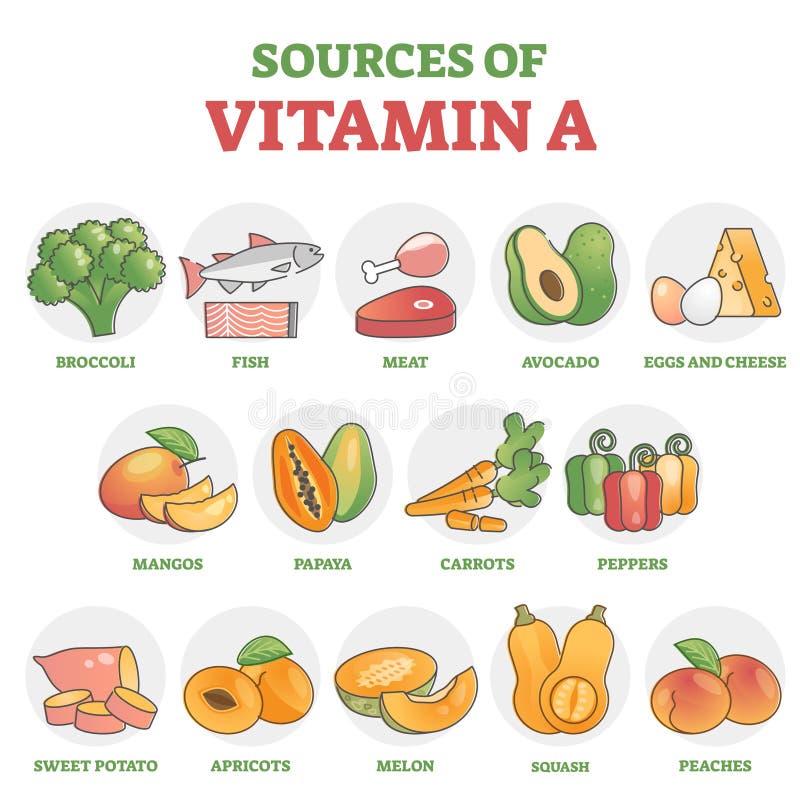Vitamin A is a group of fat-soluble compounds, including retinol, retinal and retinyl esters, found in both animal and plant foods. Most vitamins are water-soluble, meaning they dissolve in water. In contrast, fat-soluble vitamins are similar to oil and do not dissolve in water. Fat soluble vitamines are stored in body tissue for later use.
 |
| Source: OstroVit. |
Most of Vitamin A is kept in our liver in the form of retinyl esters. These esters are then broken down into all-trans-retinol, which binds to retinol-binding protein. It then enters your bloodstream for our body to use it.
There are two types of vitamin A that are found in the diet:Preformed vitamin A - retinol and retnyl esters - is found in animal products such as meat, fish, poultry, and dairy foods.
Precursors to vitamin A, also known as provitamin A carotenoids, are found in plant-based foods such as fruits and vegetables. The most common type of provitamin A is beta-carotene.
Beta-carotene is an antioxidant. Antioxidants protect cells from damage caused by substances called free radicals that contributes to certain long-term diseases and play a role in aging. Also, eating food sources of beta-carotene may reduce the risk for cancer, but beta-carotene supplements do not reduce cancer risk.
Vitamin A is also available in dietary supplements. It most often comes in the form of retinyl acetate or retinyl palmitate (preformed vitamin A), beta-carotene (provitamin A) or a combination of preformed and provitamin A.
What are its benefits to our health?
Vitamin A helps vision and eye health. Retinal, the active form of vitamin A, combines with the protein opsin to form rhodopsin, a molecule necessary for color vision and low light vision. It also helps protect and maintain the cornea, which is the outermost layer of your eye, and the conjunctiva, a thin membrane that covers the surface of your eye and the inside of your eyelids. Adequate dietary intake of vitamin A helps protect against certain eye diseases, such as age-related macular degeneration (AMD).
Additionally, vitamin A helps maintain surface tissues such as your skin, intestines, lungs, bladder, and inner ear. Vitamin A impacts immune health by stimulating responses that protect your body from illnesses and infections. Vitamin A is involved in the creation of certain cells, including B cells and T cells, which play central roles in immune responses that guard against disease. A deficiency in this nutrient leads to increased levels of pro-inflammatory molecules that diminish immune system response and function.
Provitamin A carotenoids such as beta carotene, alpha carotene, and beta cryptoxanthin are precursors of vitamin A and have antioxidant properties. Carotenoids protect your body from free radicals — highly reactive molecules that can harm your body by creating oxidative stress which has been linked to chronic conditions such as diabetes, cancer, heart disease, and cognitive decline.
Due to their antioxidant properties, carotenoid-rich fruits and vegetables may protect against certain types of cancer. For example, a study in more than 10,000 adults found that smokers with the highest blood levels of alpha carotene and beta cryptoxanthin had a 46% and 61% lower risk of dying from lung cancer, respectively, than nonsmokers with the lowest intake of these nutrients.
What’s more, test-tube studies demonstrate that retinoids may inhibit the growth of certain cancer cells, such as bladder, breast, and ovarian cancer cells
Vitamin A is essential for both male and female reproduction because it plays a role in sperm and egg development. It’s also critical for placental health, fetal tissue development and maintenance, and fetal growth. Therefore, vitamin A is integral to the health of pregnant people and their developing babies, as well as people who are trying to become pregnant.
Recommended daily intake
Infants (adequate intake):
- 0 to 6 months: 400 micrograms per day (mcg/day)
- 7 to 12 months: 500 mcg/day
The Recommended Dietary Allowance (RDA) for vitamins is how much of each vitamin most people should get each day. The RDA for vitamins may be used as goals for each person.
Children (Recommended Dietary Allowance):
- 1 to 3 years: 300 mcg/day
- 4 to 8 years: 400 mcg/day
- 9 to 13 years: 600 mcg/day
Adolescents and adults (RDA):
- Males age 14 and older: 900 mcg/day
- Females age 14 and older: 700 mcg/day (for females aged 19 to 50, 770 mcg/ day during pregnancy and 1,300 mcg/day during breastfeeding)
The best way to get the daily requirement of important vitamins is to eat a wide variety of fruits, vegetables, fortified dairy foods, legumes (dried beans), lentils, and whole grains.
What food contains Vitamin A?
Vitamin A is found in both plant and animal foods. Foods with the highest levels of vitamin A include:
- Beef liver and other organ meats (these are high in saturated fat and cholesterol, so limit the amount you eat)
- Some types of fish such as herring, king mackerel and salmon and cod fish oil
- Egg yolks
- Dairy products such as cheese and fortified milk (choose non-fat and low-fat dairy options)
- Fortified breakfast cereals
- Orange and yellow vegetables and fruits, such as carrots, sweet potatoes, mangos, and cantaloupe
- Broccoli, spinach, and most dark green, leafy vegetables
 |
| Source: Dreamstime. |
The deeper or brighter the color of a fruit or vegetable, the higher the amount of carotenoids. Vegetable sources of beta-carotene are fat- and cholesterol-free. Their absorption is improved if these sources are eaten with a small amount of fat.
What if we do not have enough Vitamin A?
If you do not get enough vitamin A, you have more risk of eye problems such as:
- Reversible night blindness
- Non-reversible corneal damage known as xerophthalmia
- Increases the severity and risk of dying from infections like measles and diarrhea.
- Risk of anemia and death in pregnant women and negatively impacts the fetus by slowing growth and development.
- Skin issues such as hyperkeratosis and acne.
Certain groups — such as premature infants, people with cystic fibrosis, and pregnant or breastfeeding people in developing countries — are more at risk of vitamin A deficiency.
What if we have too much Vitamin A?
It’s important not to exceed the Tolerable Upper Intake Level (UL) of 10,000 IU (3,000 mcg) per day for adults. Though it’s possible to consume excessive preformed vitamin A through animal-based sources like liver, toxicity is most commonly linked to excessive supplement intake and treatment with certain medications, such as isotretinoin.
Since vitamin A is fat-soluble, it’s stored in your body and can reach unhealthy levels over time. Taking too much vitamin A can lead to serious side effects and can even be fatal if you ingest extremely high doses. Acute vitamin A toxicity occurs over a short time period when a single excessively high dose of vitamin A is consumed. Chronic toxicity occurs when doses more than 10 times the RDA are ingested over a longer time span. Babies and children are more sensitive to vitamin A. They can become sick after taking smaller doses of vitamin A or vitamin A-containing products such as retinol (found in skin creams).
The most common side effects of chronic vitamin A toxicity — often referred to as hypervitaminosis A— are: vision disturbances, joint and bone pain, poor appetite, nausea and vomiting, sunlight sensitivity, hair loss, headache, dry skin, liver damage, jaundice, delayed growth, decreased appetite, confusion, itchy skin.
Though less common than chronic vitamin A toxicity, acute vitamin A toxicity is associated with more severe symptoms, including liver damage, increased cranial pressure, and even death.
What’s more, vitamin A toxicity can negatively impact the health of pregnant people and their babies and may lead to fetal development irregularities.
A high intake of dietary carotenoids is not associated with toxicity, though studies link beta carotene supplements with an increased risk of lung cancer and heart disease in people who smoke cigarettes.
Since too much vitamin A can be harmful, consult a healthcare professional before taking vitamin A supplements.

Comments
Post a Comment